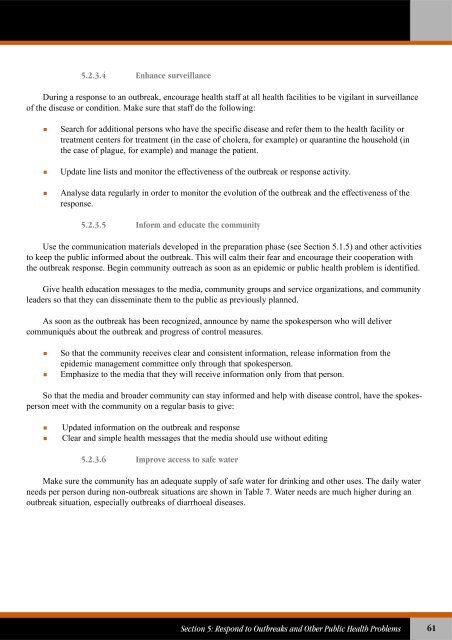Technical Guidelines for Integrated Disease Surveillance ... - PHRplus
Technical Guidelines for Integrated Disease Surveillance ... - PHRplus
Technical Guidelines for Integrated Disease Surveillance ... - PHRplus
You also want an ePaper? Increase the reach of your titles
YUMPU automatically turns print PDFs into web optimized ePapers that Google loves.
5.2.3.4 Enhance surveillanceDuring a response to an outbreak, encourage health staff at all health facilities to be vigilant in surveillanceof the disease or condition. Make sure that staff do the following:Search <strong>for</strong> additional persons who have the specific disease and refer them to the health facility ortreatment centers <strong>for</strong> treatment (in the case of cholera, <strong>for</strong> example) or quarantine the household (inthe case of plague, <strong>for</strong> example) and manage the patient.Update line lists and monitor the effectiveness of the outbreak or response activity.Analyse data regularly in order to monitor the evolution of the outbreak and the effectiveness of theresponse.5.2.3.5 In<strong>for</strong>m and educate the communityUse the communication materials developed in the preparation phase (see Section 5.1.5) and other activitiesto keep the public in<strong>for</strong>med about the outbreak. This will calm their fear and encourage their cooperation withthe outbreak response. Begin community outreach as soon as an epidemic or public health problem is identified.Give health education messages to the media, community groups and service organizations, and communityleaders so that they can disseminate them to the public as previously planned.As soon as the outbreak has been recognized, announce by name the spokesperson who will delivercommuniqués about the outbreak and progress of control measures.So that the community receives clear and consistent in<strong>for</strong>mation, release in<strong>for</strong>mation from theepidemic management committee only through that spokesperson.Emphasize to the media that they will receive in<strong>for</strong>mation only from that person.So that the media and broader community can stay in<strong>for</strong>med and help with disease control, have the spokespersonmeet with the community on a regular basis to give:Updated in<strong>for</strong>mation on the outbreak and responseClear and simple health messages that the media should use without editing5.2.3.6 Improve access to safe waterMake sure the community has an adequate supply of safe water <strong>for</strong> drinking and other uses. The daily waterneeds per person during non-outbreak situations are shown in Table 7. Water needs are much higher during anoutbreak situation, especially outbreaks of diarrhoeal diseases.Section 5: Respond to Outbreaks and Other Public Health Problems61















